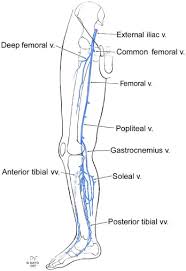
Chronic Venous insufficiency (CVI) vs. Deep Vein thrombosis (DVT)
Order Instructions:
Advanced practice nurses often treat patients with vein and artery disorders such as chronic venous insufficiency (CVI) and deep venous thrombosis (DVT). While the symptoms of both disorders are noticeable, these symptoms are sometimes mistaken for signs of other conditions, making the disorders difficult to diagnose. Nurses must examine all symptoms and rule out other potential disorders before diagnosing and prescribing treatment for patients. In this Assignment, you explore the epidemiology, pathophysiology, and clinical presentation of CVI and DVT.
To prepare:
•Review the section “Diseases of the Veins” (pp. 585–587) in Chapter 23 of the Huether and McCance text. Identify the pathophysiology of chronic venous insufficiency and deep venous thrombosis. Consider the similarities and differences between these disorders.
•Select a patient factor different from the one you selected in this week’s Discussion: genetics, gender, ethnicity, age, or behavior. Think about how the factor you selected might impact the pathophysiology of CVI and DVT. Reflect on how you would diagnose and prescribe treatment of these disorders for a patient based on the factor you selected.
•Review the “Mind Maps—Dementia, Endocarditis, and Gastro-oesophageal Reflux Disease (GERD)” media in the Week 2 Learning Resources. Use the examples in the media as a guide to construct two mind maps—one for chronic venous insufficiency and one for venous thrombosis. Consider the epidemiology and clinical presentation of both chronic venous insufficiency and deep venous thrombosis.
To complete:
Write a 2- to 3-page paper that addresses the following:
•Compare the pathophysiology of chronic venous insufficiency and deep venous thrombosis. Describe how venous thrombosis is different from arterial thrombosis.
•Explain how the patient factor you selected might impact the pathophysiology of CVI and DVT. Describe how you would diagnose and prescribe treatment of these disorders for a patient based on the factor you selected.
•Construct two mind maps—one for chronic venous insufficiency and one for deep venous thrombosis. Include the epidemiology, pathophysiology, and clinical presentation, as well as the diagnosis and treatment you explained in your paper.
This Assignment is due by Day 7.
Please use the writer who did my last mine map if possible. Thank you.
SAMPLE ANSWER
Chronic Venous insufficiency (CVI) vs. Deep Vein thrombosis (DVT)
Chronic Venous insufficiency occurs when the valves in the venous system malfunction. This is facilitated by various incidences such as age, smoking, and increased physical inactiveness. When the valves are damaged, they cause the blood to flow back. This forms blood clot in the vein found along the hind limb, causing a disease condition known as Deep Vein Thrombosis (DVT). The clinical manifestation of the disease includes swelling of the ankle if the patient stands of sits for a long period. The swelling is sometimes painful and causes flaking of the skin and itchiness (Davies, Lumsden, & Vykoukal, 2011). Deep Vein Thrombosis (DVT) is a cardiovascular complication that results when the venous valves located at the hind limb becomes damaged. The venous system transports deoxygenated blood from the rest of the body to the heart for oxygenation. During this cycle, blood flows upwards from legs to the heart. For this to occur, the muscles of the feet and the calf contract, squeezing the veins which then propel blood upward towards the heart. The vein has valves are aligned in one direction and facilitate blood transportation. Consequently, blood circulation is disturbed, making it difficult for blood to circulate effectively and blood pools in these veins (Kibbe, Pearce, & Yao, 2010).
CVI and DVT compare in that the diagnostic process is similar and includes use of duplex ultrasound technology to check the blood circulation process. The technique applied is as follows, the transducer part of the machine is normally placed on the site that s directly above the vein in question, the waves on how the blood is flowing together with a 3D formulation of the vein anatomical structure is displayed on the monitor. This diagnosis is important because it is able to diagnose early enough, and the disease gets treated using the appropriate medication. The pharmacological medication is often coupled with on pharmacological medication, such as weight loss, exercises, and the reduction of environmental stressors such as standing for a long period. Other measures include compression stockings and taking antibiotic (Huether, & McCance, 2012).
Evidence based research indicates that the CVI and DVT prevalence illustrate healthcare disparity. This is mainly due to the interactions of healthcare determinants such as genetic, environmental factors, ethnic background, and socioeconomic status. The prevalence rate is high among the African American, Hispanics, and Caucasians as compared to White. Literature associates these findings with environmental exposures and socio economic background. For instance, the white population has high rates of educated people and low rates of low household income (Kibbe, Pearce, & Yao, 2010). This implies that they are able to access the hospital routinely and are treated early before the disease clinical manifestations become worse. On the other hand, these other communities have the highest number of dropouts. The children are more susceptible to drugs and poor living condition at a tender age. Additionally, the high hospital cost act as an obstacle to accessing quality care. Therefore, these people will really on alternative therapies and over counter drugs for a long period, and will only access care during the last stage of the disease. These communities have the highest rates of obesity, which is a main risk factor to DVT and CVI (Murphy & Lloyd, 2013).
References
Davies, M., Lumsden, A., & Vykoukal, D. (2011). Chronic venous insufficiency. Minneapolis: Cardiotext Pub.
Huether, S. E., & McCance, K. L. (2012). Understanding pathophysiology (Laureate custom ed.). St. Louis
Kibbe, M., Pearce, W., & Yao, J. (2010). Venous disorders. Shelton, Conn.: People’s Medical Pub. House—USA.
We can write this or a similar paper for you! Simply fill the order form!




